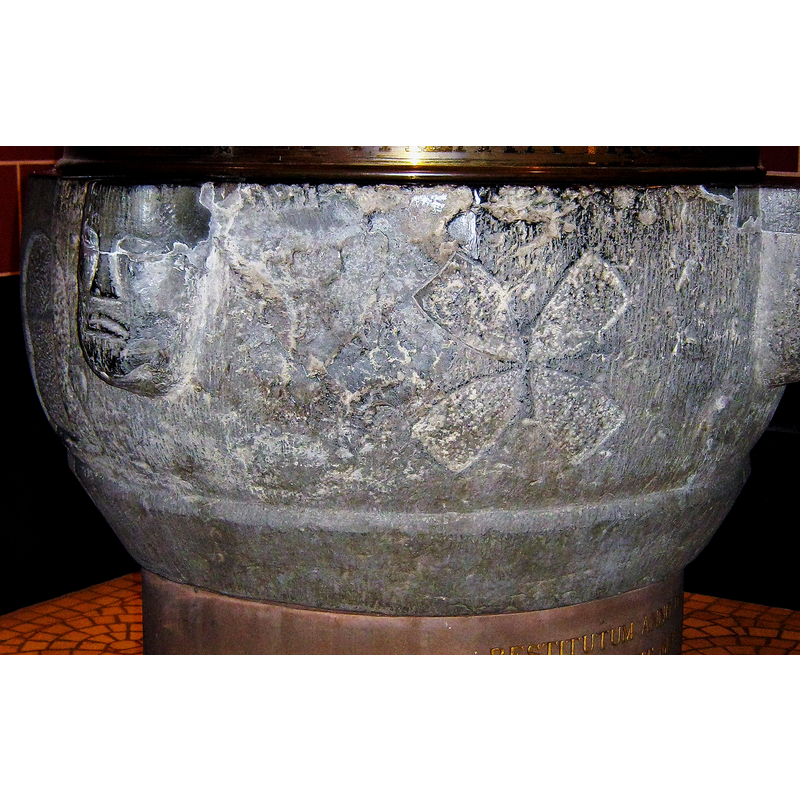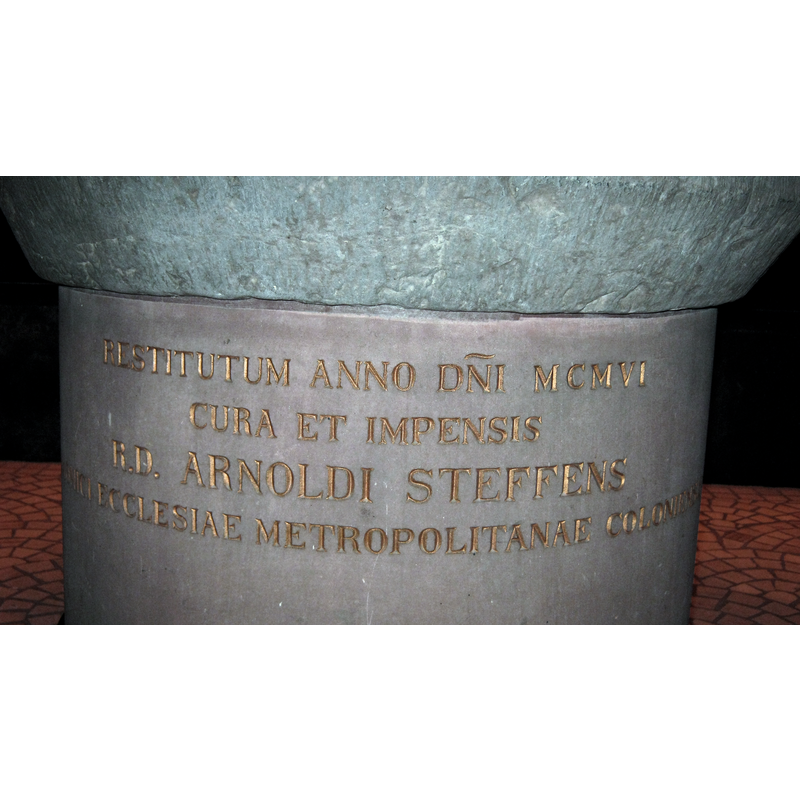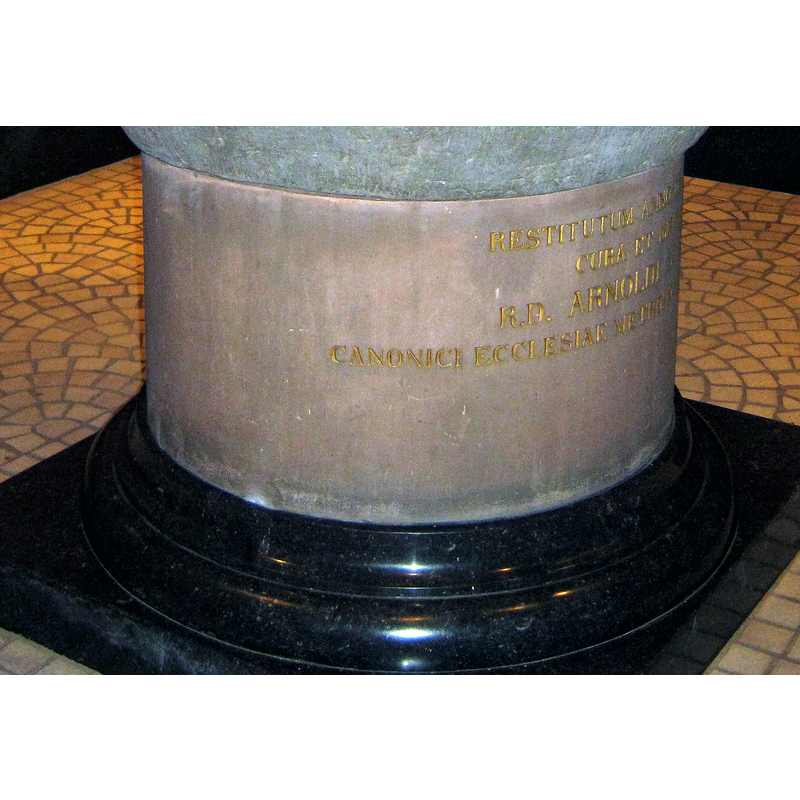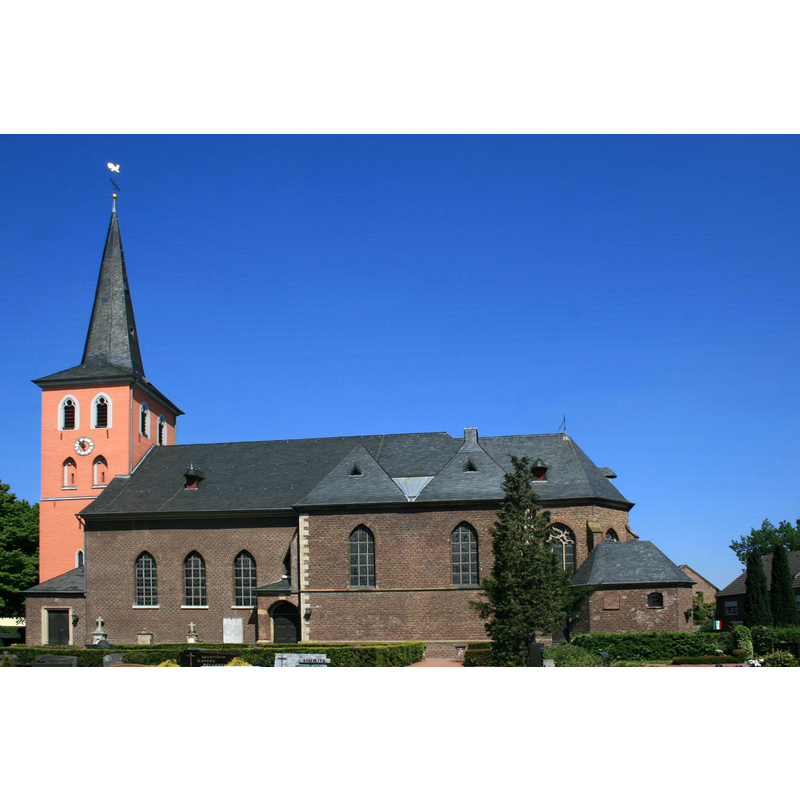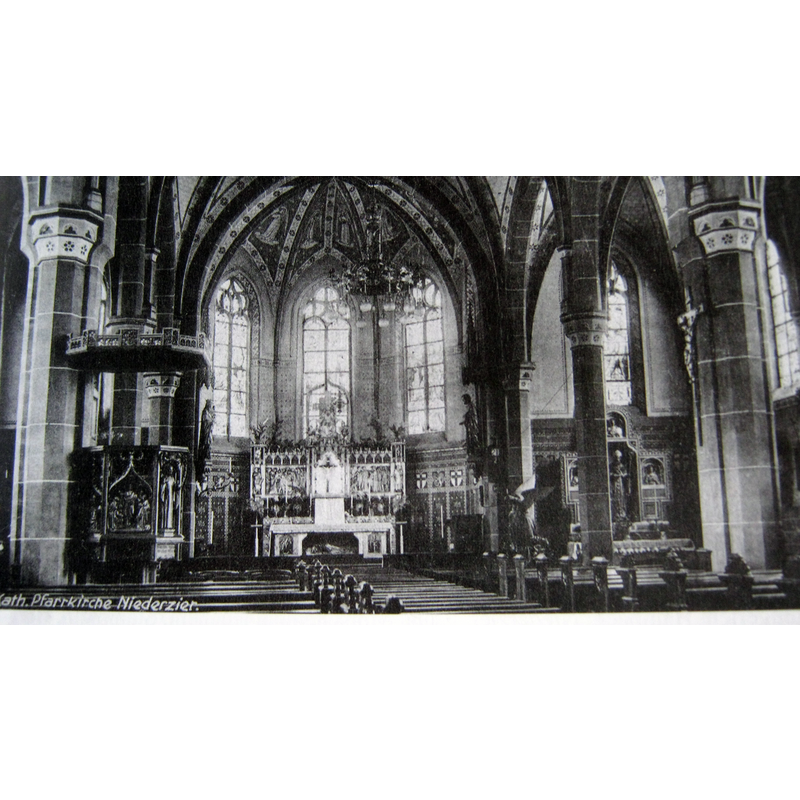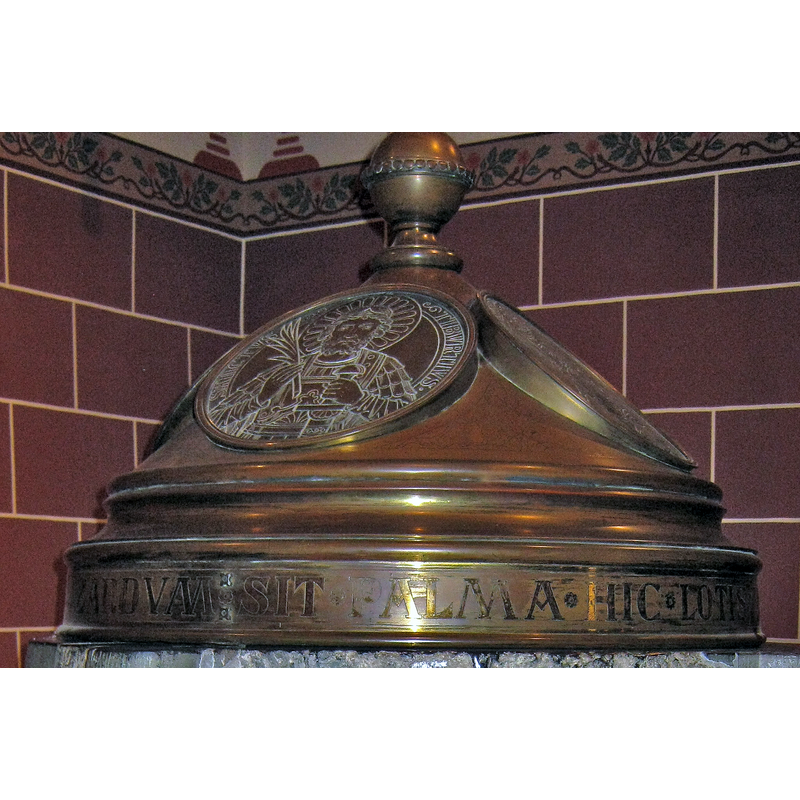Niederzier
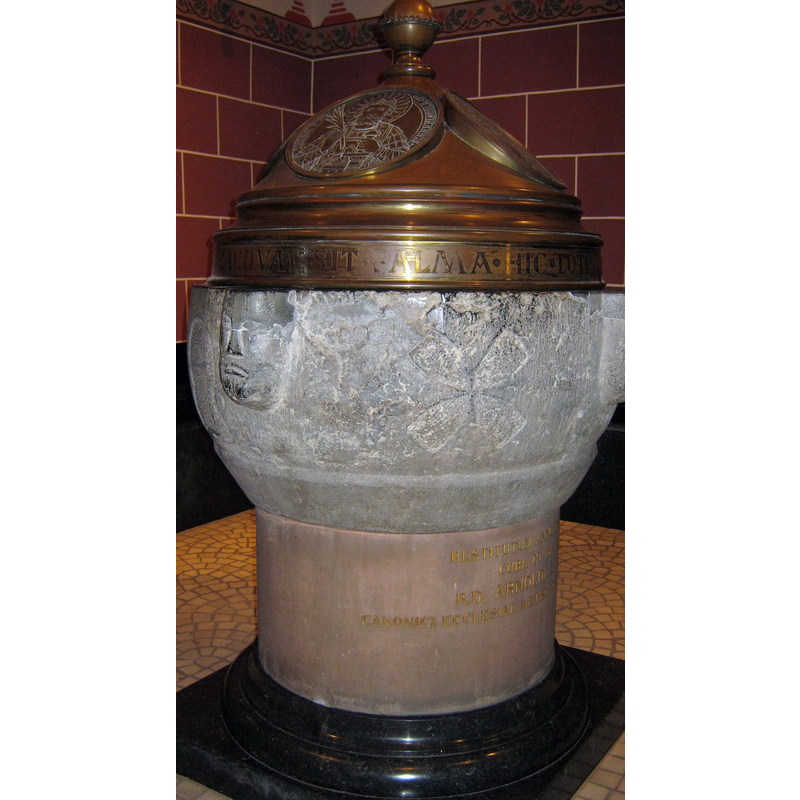
Image copyright © 21MB, 2014
CC-BY-SA-4.0
Results: 8 records
design element or symbol - varied
Scene Description: a potent cross on this side
Copyright Statement: Image copyright © 21MB, 2014
Image Source: edited detail of a digital photograph 20 August 2014 by 21MB [https://commons.wikimedia.org/wiki/File:Taufstein_St._Cäcilia.jpg] [accessed 28 September 2023]
Copyright Instructions: CC-BY-SA-4.0
human figure - head - 4
Scene Description: set at 90-degree angles om the sides of the basin
Copyright Statement: Image copyright © 21MB, 2014
Image Source: edited detail of a digital photograph 20 August 2014 by 21MB [https://commons.wikimedia.org/wiki/File:Taufstein_St._Cäcilia.jpg] [accessed 28 September 2023]
Copyright Instructions: CC-BY-SA-4.0
inscription
Scene Description: identifying the donor as Cathedral Canon Arnold Steffens
Copyright Statement: Image copyright © [in the public domain]
Image Source: digital photograph 20 August 2014 by 21MB [https://commons.wikimedia.org/wiki/File:Taufsteinsockel.jpg] [accessed 28 September 2023]
Copyright Instructions: CC-BY-SA-4.0
view of base
Scene Description: the modern replacement base of 1906
Copyright Statement: Image copyright © 21MB, 2014
Image Source: edited detail of a digital photograph 20 August 2014 by 21MB [https://commons.wikimedia.org/wiki/File:Taufstein_St._Cäcilia.jpg] [accessed 28 September 2023]
Copyright Instructions: CC-BY-SA-4.0
view of church exterior - south view
Scene Description: Source caption: "Pfarrkirche St. Cäcilia, Bauzeit: 1852, 1845, Adresse: Breite Straße 29 in Niederzier (OT Niederzier), Eintrag in die Denkmalliste: 30.04.1986"
Copyright Statement: Image copyright © Käthe und Bernd Limburg, 2010
Image Source: digital photograph 2010 by Käthe und Bernd Limburg [https://commons.wikimedia.org/wiki/File:Niederzier_Denkmal-Nr._14,_Breite_Straße_29_(1474).jpg] [accessed 28 September 2023]
Copyright Instructions: CC-BY-SA-3.0-DE
view of church interior - looking east
Scene Description: Source caption: "Pfarrkirche St. Cäcilia vor dem 2. Weltkrieg"
Copyright Statement: Image copyright © 21MB, 2014
Image Source: digital image 28 July 2013 by 21MB of an undated [pre-WWII] B&W photograph [https://commons.wikimedia.org/wiki/File:Pfarrkirche_St._Cäcilia_vor_dem_2._Weltkrieg_(2).jpg] [accessed 28 September 2023]
Copyright Instructions: CC-BY-SA-4.0
view of font and cover
view of font cover
Scene Description: the cover is modern as well
Copyright Statement: Image copyright © 21MB, 2014
Image Source: edited detail of a digital photograph 20 August 2014 by 21MB [https://commons.wikimedia.org/wiki/File:Taufstein_St._Cäcilia.jpg] [accessed 28 September 2023]
Copyright Instructions: CC-BY-SA-4.0
INFORMATION
FontID: 24959NIE
Object Type: Baptismal Font1
Church/Chapel: Römisch-katholische Pfarrkirche St. Cäcilia, Niederzier
Church Patron Saints: St. Cecilia [aka Caecelia, Cecelia]
Church Location: Breite Str. 31, 52382 Niederzier, Germany -- Tel. 02428 15 77
Country Name: Germany
Location: Düren, Nordrhein-Westfalen
Directions to Site: Located off the L12-K2 crossroads, E of the L264, 8-9 km N of Düren
Ecclesiastic Region: Erzdiözese Köln
Font Location in Church: Inside the church, in the baptistry chapel, beneath the tower
Century and Period: 13th - 14th century (mid?) [basin only], Medieval [composite]
Credit and Acknowledgements: We are grateful to Pol Herman for bringing this font to our attention, and to him and JeanClaude Ghislain for their help in documenting it
Church Notes: a priest here was documented in 1122; the church was consecrated 1165; modified or re-built mid-16thC; damaged. looted and vandalised in Thirty Years' War; re-built 1824-1826
Font Notes:
Click to view
The font is noted in Arnold Steffens, Zeitschrift für christliche Kunst, 20. Nr. 5, 1907: 155-156, as a Romanesque ["Aus der Mitte des XII. Jahrh"] basin that was found buried during construction work in 1772; Steffens [cf. infra] was cathedral canon and had the font re-mounted on a base he donated himself, a base that bears his name in an inscription [cf. ImagesArea]. The entry for this church in St. Cäcilia, Eine Seite der Pfarrgemeinde Niederzier [https://st-caecilia-niederzier.de/unsere-gemeinste-st-cacilia-im-netz/taufkapelle/] [accessed 28 September 2023] informs that the chapel at the base of the tower was re-purposed as baptistery after 1923, and one of the oldest furnishings, the mid-12th century baptismal font was placed in its centre; the basin of the font is made of blueish limestone and is decorated with four human heads with crosses between them; the old basin had been unearthed during construction work in 1772; the present base of the font was installed in 1906, donated by Arnold Steffens, cathedral canon ["Einer der ältesten Einrichtungsgegenstände der Kirche, ein Taufstein aus der Mitte des 12. Jh., wurde mittig platziert. Das romanische Becken besteht aus einer derben Blausteinarbeit mit vier Eckköpfen und schlichten Ornamenten dazwischen. Es wurde 1772 bei der Errichtung eines Missionskreuzes bei Fundamentarbeiten gefunden. Auf dem Unterbau des Taufsteines wird darauf verwiesen, dass sich Domkapitular Arnold Steffens im Jahre 1906 für die Wiedererrichtung eingesetzt hat"]. The metal font cover is also modern, dome-shaped with large medallions on the sides of the come, and a running inscription on the lower sides; decorated ball finial.
A communication to BSI from Pol Herman (e-mail of 29 September 2023) includes a comment on this font by Jean-Claude Ghislain (from a JCG e-mail of 22 November 2022 to PH): "La cuve de Niederzier en Rhénanie proche est nettement postérieure à 1165, la date de la consécration de l'église. Il s'agit d'une cuve tardive de la première moitié du 13e siècle d'une exécution sommaire. Les têtes présentent certains détails gothiques perceptibles dans la forme des yeux et de la bouche. Certains ateliers régionaux ont produit nombre de cuves dérivées du type mosan.
Cordialement, Jean-Claude". Pol Herman adds: "My opinion : the trefoil arches and the cross potent are fairly common on the “Mosan”-type late Romanesque fonts, manufactured in the German Rhineland in the 13th century. It would even be better not to call these fonts “Mosan”, because they are not produced in that area. Pol"
COORDINATES
Church Latitude & Longitude Decimal: 50.88547, 6.46282
Church Latitude & Longitude DMS: 50° 53′ 7.69″ N, 6° 27′ 46.15″ E
UTM: 32U 321541 5640155
MEDIUM AND MEASUREMENTS
Material: stone, limestone
Font Shape: hemispheric (mounted)
Basin Interior Shape: round
Basin Exterior Shape: round
LID INFORMATION
Date: modern
Material: metal
Apparatus: no
Notes: [cf. FontNotes]
